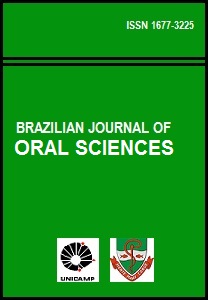Abstract
The aim of the present study was to verify if there is any difference in the pulp chamber temperature rise during the photo-activation of two resin composites with different viscosities. Eighteen extracted bovine incisors were divided into two groups (n=9) that were restored with two different resin composites – Filtek Z250 and Filtek Flow (3M/ESPE Dental Products, St Paul, MN 55144, USA). During the photo-activation, with a conventional halogen light curing unit (XL 2500, 3M/ESPE), a type-K thermocouple registered the temperature rise peak in the pulp chamber. The temperature rise data were submitted to Student-t test at 5% significance. The resin composite Filtek Flow shows statically higher mean temperature rise (p<0.05). We conclude that the resin composites with different viscosities produce different temperature changes during the photo-activation.References
Peutzfeldt A. Resin composites in dentistry: the monomer systems. Eur J Oral Sci 1997; 105: 97-116.
Moszner N, Salz. New developments of polymeric dental composites. Prog Polym Sci. 2001; 26: 535-76.
Anusavice KJ. Phillip’s Science of Dental Materials. 10th ed. Philadelphia (PI): Saunders; 1998.
Ferracane JL. Current trends in dental composites. Crit Rev Oral Biol Med 1995; 6: 302-18.
Guggenberger R, Weinmann W. Exploring beyond methacrylates. Am J Dent 2000; 13: 82-4.
Knezevic A, Tarle Z, Meniga A, Sutalo J, Pichler G, Ristic M. Degree of conversion and temperature rise during polymerization of composite resin samples with blue diodes. J Oral Rehabil 2001; 28: 586-91.
Rueggeberg F. Contemporary issues in photocuring. Compend Contin Educ Dent Suppl 1999; 20: S4-15.
Uhl A, Mills RW, Jandt KD. Polymerization and light-induced heat of dental composites cured with LED and halogen technology. Biomaterials 2003; 24: 1809-20.
Lloyd CH, Brown EA. The heats of a reaction and temperature rises associated with the setting of bonding resins. J Oral Rehabil 1984; 11: 319-24.
McCabe JF. Cure performance of light-activated-composites by differential thermal analysis (DTA). Dent Mater 1985; 1: 231-4.
Goodis HE, White JM, Andrews J, Watanabe LG. Measurement of temperature generated by visible-light-cure lamps in an in vitro mode. Dent Mater 1989; 5: 230-4.
Hansen EK, Asmussen E. Correlation between depth of cure and temperature rise of a light-activated resin. Scand J Dent Res 1993; 101: 176-9.
Smail SRJ, Patterson CJW, McLundie AC, Strang R. In vitro temperature rises during visible-light curing of a lining material and a posterior composite. J Oral Rehabil 1988; 15: 361-6.
Porko C, Hietala EL. Pulpal temperature change with visible light-curing. Oper Dent 2001; 26: 181-5.
Lisanti VF, Zander HA. Thermal injury to normal dog teeth: in vivo measurements to pulp temperature increases and their effect on the pulp tissue. J Dent Res 1952; 31: 548-58.
Zach L, Cohen G. Pulp response to externally applied heat. Oral Surg Oral Med Oral Pathol 1965; 19: 515-30.
McCabe JF, Wilson HJ. The use of differential scanning calorimetry for the evaluation of dental materials. J Oral Rehabil 1980; 7: 235-43.
Shortall AC, Harrington E. Temperature rise during polymerization of light-activated resin composites. J Oral Rehabil 1988; 25: 908-13.
Brown WS, Dewey WA, Jacobs MR. Thermal properties of teeth. J Dent Res 1970; 49: 752-5.
White SM, Fagan MC, Goodis HE. Intrapulpar temperatures during pulse Nd: YAG laser treatment of dentin, in vitro. J Periodontol. 1994; 65: 255-9.
Thompson MN, Gomez HF, Puckett AD. Pulpal temperature changes after exposure to a light curing source [abstract 524]. J Dent Res 1997; 76: 79.
Arikawa H, Fujii K, Kanie T, Inoue K. Light transmittance characteristics of light-cured composite resins. Dent Mater 1998; 14: 405-11.
Tanoue N, Koishi Y, Matsumara H, Atsuta M. Curing depth of different shades of a photoactivated prosthetic composite material. J Oral Rehabil 2001; 28: 618-23.
Masutami S, Setcos JC, Schinell RJ, Phillips RW. Temperature rise during polymerization of visible light-activated composite resins. Dent Mater 1988; 4: 174-8.
Harrington E, Wilson HJ, Shortall AC. Light activated restorative materials: a method of determining effective radiation times. J Oral Rehabil 1996; 23: 210-8.
Asmussen E. Factors affecting the quantity of remaining double bonds in restorative resin polymers. Scand J Dent Res 1982; 90: 490-6.
Lloyd CH, Joshi A, Mcglynn E. Temperature rises produced by light sources and composites during curing. Dent Mater 1986; 2: 170-4.
Loney RW, Price RBT. Temperature transmission of high-output light-curing units through dentin. Oper Dent 2001; 26: 516-20.
Baldissara P, Catapano S, Scotti R. Clinical and histological evaluation of thermal injury thresholds in human teeth: a preliminary study. J Oral Rehabil 1997; 24: 791-801.
The Brazilian Journal of Oral Sciences uses the Creative Commons license (CC), thus preserving the integrity of the articles in an open access environment.

